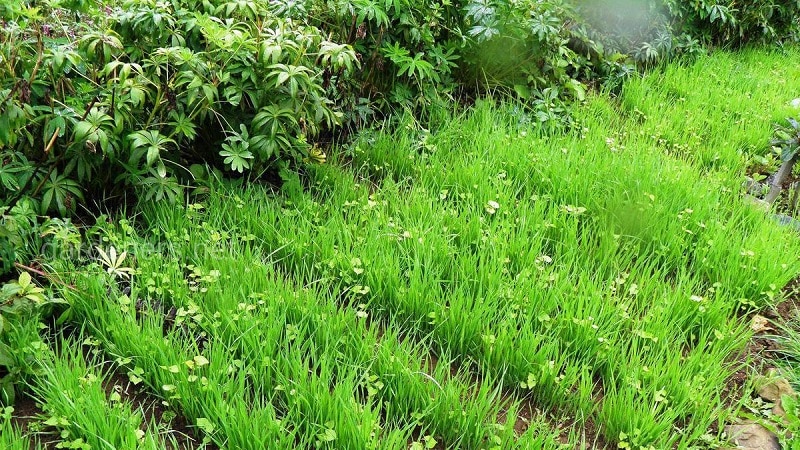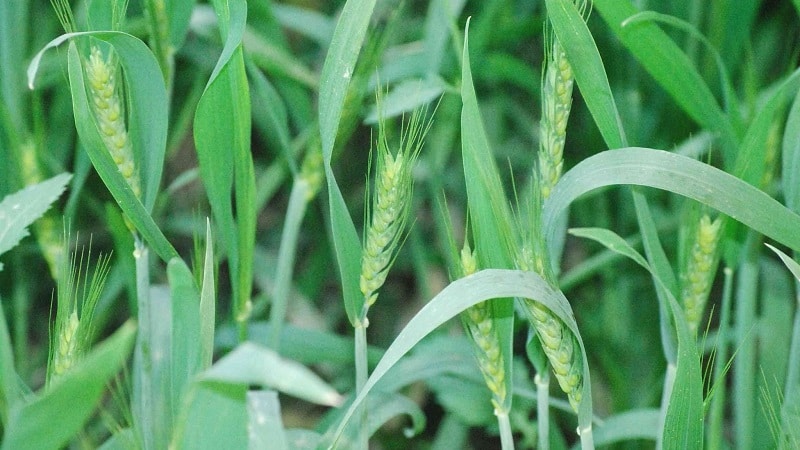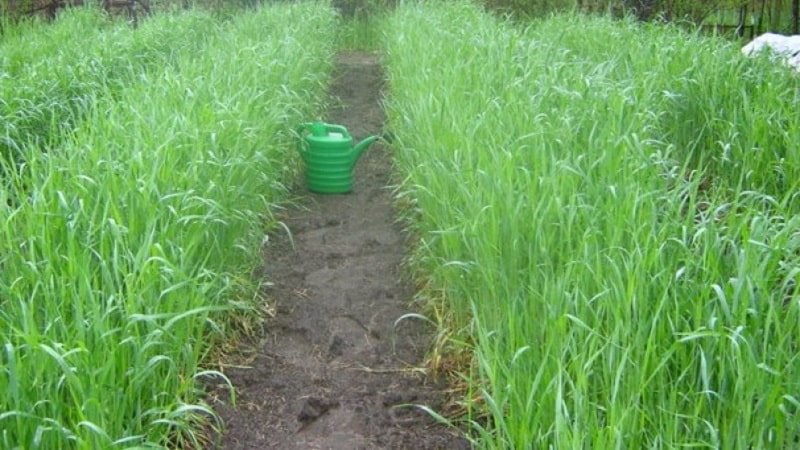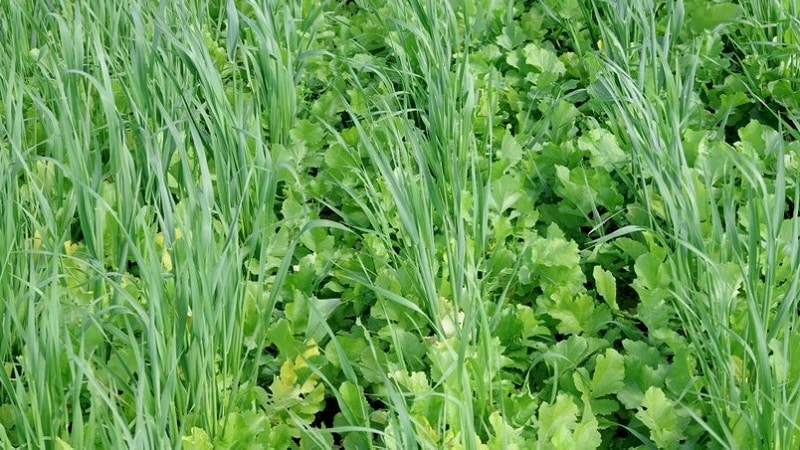How and when to mow oats as green manure
Soil greening is a safe, effective and low-cost way to enrich the soil with nutrients and improve its structure.
A wide variety of crops are used as green manure. These include cereals, legumes, and cruciferous vegetables. Among cereal crops, oats, rye, and wheat are widely used. In this article we will talk in detail about how and when to sow and mow oats, as well as the advantages and disadvantages of oats as green manure.
The meaning of soil greening
Green manure involves plowing green mass of plants into the soil in order to enrich it nitrogen and organic matter.
Such plants are used mustard, rapeseed, oilseed radish, rye, barley, alfalfa, clover, buckwheat, oats and other crops.
Need to know. Sowing plants with a developed root system and lush greenery fills the soil with organic matter and improves its structure.
This technique serves as an alternative to artificial fertilizers and partially suppresses the growth of weeds.

Correctly carried out green manure loosens and fertilizes the soil, protects the soil from leaching of nutrients and minerals, helps enrich the soil with nitrogen.
Grass clippings are used as mulch to protect against frost and conserve soil moisture.
Interesting things on the site:
What is good about rye, how is it a green manure and how to plant it correctly
Choosing the best green manure for cucumbers in the fall for greenhouses
Advantages and disadvantages of oats as green manure
Oats are one of the oldest cereal crops grown in Rus'. They began to use this cereal as a fertilizer recently.
Its advantages:
- When decomposed, embedded greens saturate the soil with organic, mineral substances and nitrogen. To more effectively saturate the soil with nitrogen, oats are sown in a mixture with legumes.
- The cereal is unpretentious and suitable for sowing on all types of soils from black soil to loam.
- The developed root system of the plant loosens the soil. Oats are especially good for heavy dense soils. It improves their structure and saturates with oxygen. When sown on light soils, oats strengthen the top layer and protect it from leaching and weathering.
- Densely planted oats displace weeds from the site.
- Oat seeds are sown both in early spring and autumn, because they germinate even at temperatures close to zero.

Flaws:
- Small volume of green mass compared to other green manure plants.
- Weak soil saturation with nitrogen. This disadvantage is compensated by simultaneous sowing of oats and legumes.
- Demanding on soil moisture.
- Slow growth at elevated temperatures. For this reason, it is not recommended to sow oats in summer.
Features of cultivation
Oats are a cold-resistant plant. The optimal conditions for its growth and active growth of biomass are cool and humid weather.
Attention. Oats are sown as fertilizer in early autumn and spring.
Which crops to sow in front of?
Oats, like any grain, attract wireworms. Therefore, potatoes are not planted immediately after it.
It is best to sow this green fertilizer before cabbage, tomatoes, raspberries, strawberries, eggplants, onions, peppers.
Planting in autumn
Sowing oats to fertilize the soil in the fall is carried out so that the plants have time to grow greenery before the arrival of cold weather.. The exact sowing dates are determined based on the expected start date of frost.
Is it possible to sow oats before winter? Yes, but then the seeds of winter varieties are chosen, and the green mass is cut in the spring, when it grows.
Before autumn sowing, complex mineral fertilizers are applied. Then the plants will receive adequate nutrition and will be pleased with the green mass. When mixing oat seeds with vetch, the dose of nitrogen is reduced by 50%.
Seeding rate – 1-2 kg of grains per hundred square meters. Sowing is carried out manually, scattering seeds on moist soil and sprinkling with earth, or using special devices.
Before sowing, the seed material is treated potassium permanganate or boric acid to protect seedlings from fungus.

Planting in spring
In spring, cereals are planted as soon as the snow melts. During this period, the ground is saturated with moisture, and the weather is still cool. These are the best conditions for the growth of green manure.
Sowing is carried out so that there are a couple of months left before planting the main crop.. Within 30-40 days, the cereal grows greenery and it takes at least two more weeks for the fertilizer to rot in the soil.
Summer landing
There is no point in sowing this cereal in summer, so it does not tolerate heat well and will not be able to build up sufficient biomass. In addition, in summer there is little moisture for oats and the plantings will have to be watered additionally.
Rules of care
Oat plantings do not require special care. Plants are additionally watered only if the spring is dry and warm. Oats do not tolerate drought.
Before sowing before winter, mineral fertilizers are applied to the soil. Then the green manure will receive the necessary nutrition for active growth of biomass in the spring.
Read also:
What are the types and varieties of oats?
What are the benefits of oat water, how to prepare and drink it
Mowing and embedding into the ground
When to mow oats planted as green manure? Before the ears appear, when the panicle appears. In order for the mown mass to ripen faster, it is crushed with a shovel before embedding. Delaying the mowing time will lead to the stems becoming stiff and rotting in the soil for a long time.
2-3 weeks after cutting and embedding the biomass into the soil, they plant main culture.
Do I need to dig up the beds? This is not necessary. Mown but not buried oat stalks will cover the soil and protect it from freezing. This autumn green manure is planted in the spring.

Important tips and recommendations from experienced gardeners
Advice and recommendations from experienced gardeners will help get the most out of sowing oats as a green manure:
- On sandy soils, the greens are mowed, but the ground is not dug up. Then the roots of the oats will strengthen the fertile layer of soil and protect it from leaching and weathering.
- On fertile soils, green manure is plowed in, and the main crops are planted on top.
- In spring, sow as early as possible to make the most of spring moisture and cool weather.
- In the fall, oats are sown early so that they have time to grow green before the onset of frost. Or they use winter sowing.
- If there is a lot of greenery, some of it is put into compost or used as mulch. If you plant too many stems and leaves in the ground, they will not have time to rot.
- To combat weeds, seeding rates are increased to 5-6 kg per hundred square meters. With such density, weeds have no chance.
- Oats, like other grains, are not sown before potatoes.But planting immediately after potatoes is of great benefit, as it helps fight potato scab.
Reviews
Here are a few reviews from summer residents who grow oats as green manure.
Valeria Sergeevna, p. Tselinnoe: “I use oats as a green manure along with rye and wheat. Thanks to this, I have completely fertilized and fertile soil in my garden. The yield of raspberries has increased, although before this it bore fruit very poorly.”.
Petr Viktorovich, village Elan: “I sow oats in the spring to protect against weeds. And the quality of the harvest is invariably pleasing; onions have begun to grow better.”.
Olga, Tomsk: “Oats as green manure helped me grow an enviable harvest of strawberries. The bushes have become lush and beautiful, and the berries are large and tasty. Now I recommend this method to everyone I know.".
Conclusion
Oats are good not only as a food cereal crop, but also as a fertilizer for the soil. Its developed root system improves the soil structure. Regular sowing of cereals in empty plots increases the yield of garden crops. It helps fight weeds on the site.
It is good to use oat fertilizer in a mixture with other green manure crops. An integrated approach to green manure saturates the soil with all the nutrients necessary for cultivated plants.